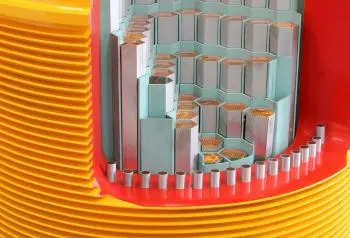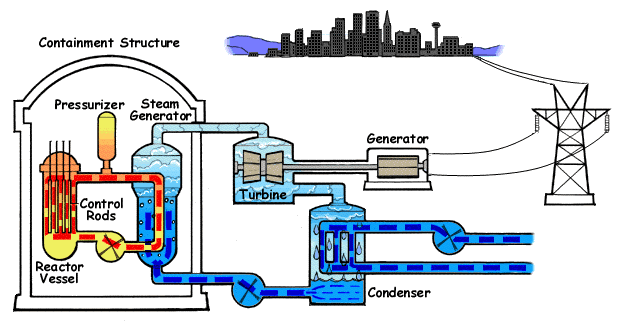
Nuclear reactors are part of nuclear power plants. The purpose of a reactor is to obtain energy from nuclear energy.
The most common use of this type of reactor is the production of electrical energy. In nuclear reactors fission chain reactions (splitting of uranium atoms) are generated to produce thermal energy. The rest of the nuclear power plant will be responsible for using this energy to convert it into electricity.
The differences between the different types of nuclear power plants are based on the way the nuclear reactor they use to produce electricity works.
The most common types of nuclear reactors are:
-
Pressurized water reactor (PWR)
-
Boiling Water Reactor (BWR)
-
Natural Uranium Gas Graphite Reactor (GCR)
-
Advanced Gas Reactor (AGR)
-
Elevated Temperature Gas Cooled Reactor (HTGCR)
-
Heavy Water Nuclear Reactor (HWR)
-
Fast breeder reactor (FBR)
Pressurized water reactor (PWR)

The pressurized water reactor is the most widely used nuclear reactor in the world alongside the boiling water reactor (BWR). This reactor has been developed mainly in the United States, RF Germany, France and Japan.
The nuclear fuel used is enriched uranium in the form of oxide.
The moderator and the coolant used can be water or graphite.
The thermal energy generated by the reactor core is transported by the cooling water that circulates under high pressure to a heat exchanger. The reactor is based on the principle that water subjected to high pressure can evaporate without reaching the boiling point.
In the exchanger the steam is cooled and condensed, and returns to the reactor in a liquid state.
In the exchange, the heat passes to a secondary water circuit. The water in the secondary circuit is converted into high pressure steam that will be used to drive the steam turbines. Turbines provide mechanical energy to drive the electric generator and obtain electricity.
Boiling Water Reactor (BWR)
The boiling water reactor (known by the acronym in English BWR), is also used frequently. Technologically it has been developed mainly in the United States, Sweden and West Germany.
In this type of nuclear reactor, it uses water as a coolant and a neutron moderator.
The nuclear fuel used is enriched uranium in the form of oxide since it facilitates the generation of nuclear fissions.
Thermal energy generated by nuclear fission chain reactions is used to boil water. The steam produced is fed into a turbine that drives an electric generator. The steam that comes out of the turbine passes through a condenser, where it is transformed back into liquid water to repeat the cycle.
Natural Uranium Gas Graphite Reactor (GCR)
The natural uranium gas graphite reactor is a type of nuclear reactor that uses natural uranium in the form of metal as a nuclear fuel. The fuel is introduced into tubes of a magnesium alloy called magnox.
The neutron moderator used is graphite. The thermal cooler is gas, specifically carbon dioxide (CO 2 ).
The technology of this type of nuclear reactor has been developed mainly in France and the United Kingdom.
Advanced Gas Reactor (AGR)
The advanced gas reactor (AGR) has been developed in the UK from the natural uranium-graphite-gas nuclear reactor.
The main novelties are that the nuclear fuel, in the form of enriched uranium oxide, is introduced into stainless steel tubes and that the prestressed concrete vessel contains the heat exchangers inside.
Elevated Temperature Gas Cooled Reactor (HTGCR)
The elevated temperature gas-cooled nuclear reactor is a new evolution of gas-cooled nuclear reactors.
The differences with respect to the advanced nuclear gas reactor (AGR) are mainly three:
-
Helium is replaced by carbon dioxide as a refrigerant,
-
ceramic fuel is used instead of metallic fuel
-
the temperatures of the gas with which it works are much higher.
Heavy Water Nuclear Reactor (HWR)
The heavy water nuclear reactor is a type of nuclear reactor developed mainly in Canada. A variant of this reactor is the CANDU nuclear reactor , very popular in Canada.
The fuel used to obtain nuclear energy is natural uranium, in the form of oxide, which is introduced into alloyed zirconium tubes.
The main feature of the heavy water reactor is the use of heavy water as a moderator and coolant.
In its most common design, the nuclear fuel tubes are inserted into a vessel containing the moderator. The refrigerant is kept under pressure to maintain its liquid state. The steam is produced in heat exchangers through which the light water circulates.
Fast breeder reactor (FBR)
The main characteristic of fast reactors is that they do not use a neutron moderator and that, therefore, most nuclear fissions are produced by fast neutrons.
The core of this type of nuclear reactor consists of a fissile zone, surrounded by a fertile zone in which natural uranium is transformed into plutonium. The uranium 233-thorium cycle can also be used.
The refrigerant is liquid sodium, the vapor is produced in heat exchangers.
How else can nuclear reactors be classified?
Nuclear reactors can be classified according to different criteria. One of the criteria is the purpose for which they are to be used. In this sense, we distinguish the following purposes:
-
Civil: electricity generation, nuclear medicine, industrial uses, etc.
-
Military: creation of military weapons or as a propulsion system for war vehicles (military submarines, etc.)
-
Research: Research nuclear reactors used to develop nuclear power technology in different fields, both civil and military.
There are other classifications of the types of nuclear reactors depending on the criteria used. Among the most common criteria are:
-
According to the nuclear fuel used, we find natural uranium nuclear reactors and enriched uranium nuclear reactors. Other reactors use mixed oxides of uranium and plutonium.
-
According to the speed of the neutrons, that is, their kinetic energy, produced in nuclear fission reactions: fast reactors and thermal reactors are distinguished.
-
Depending on the moderator used, they can be heavy water, light water or graphite nuclear reactors.
-
Depending on the material used as coolant: the most common materials are a gas (helium or carbon dioxide) or water (light or heavy). Sometimes these materials, at the same time, also act as neutron moderators. Steam, molten salts, air, or liquid metals can also be used as a coolant.
-
Nuclear reactors can also be distinguished by the type of nuclear reaction: whether they are fission or fusion reactions. Currently, all nuclear reactors in production are nuclear fission reactors. The nuclear fusion reactor is in the research and development phase.